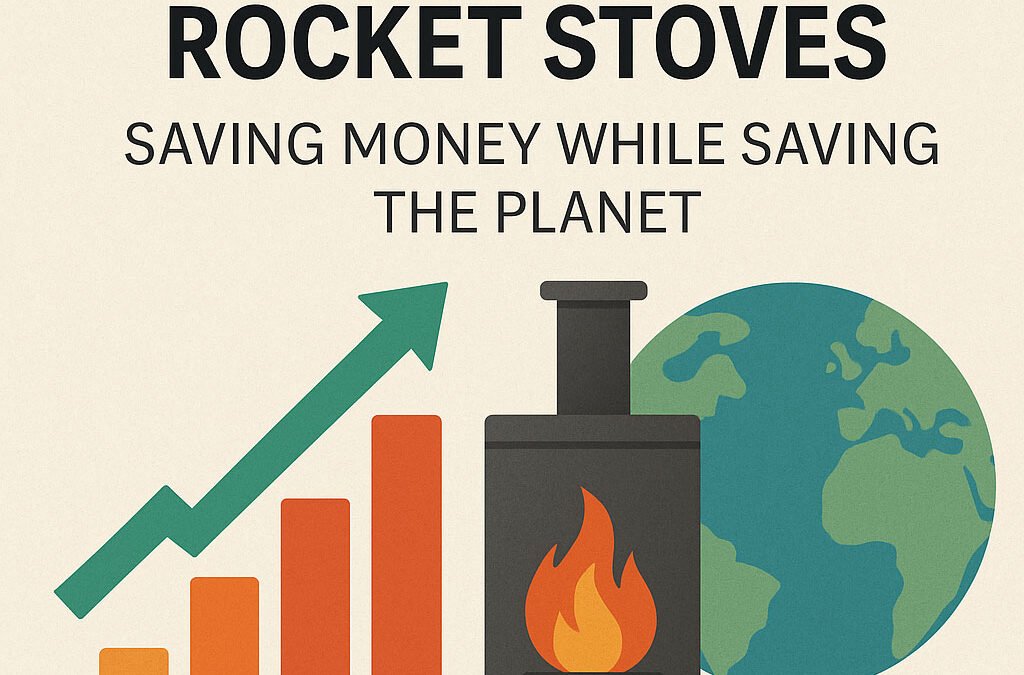The Economics of Rocket Stoves: Saving Money While Saving the Planet
“Cleaner, hotter, with less fuel.” That’s the promise of well-designed rocket stoves. This post breaks down the rupees-and-cents (and dollars-and-sense) of switching from traditional stoves and fuels to high-efficiency rocket appliances—plus the long-term environmental upside that compounds over time.
Why rocket stoves save money
Rocket stoves combine three money-saving features:
- High combustion efficiency – more of the fuel’s energy turns into useful heat (less wasted as smoke).
- Optimized heat transfer – hot gases are directed across the pot/heat-exchange surfaces where you actually need them.
- User behavior fit – fast light-up, steady burn, and controllable power mean less over-firing and less “just in case” fuel use.
Typical results: 40–70% less fuel for the same heat service (space heating and/or cooking), depending on the baseline stove and fuel quality.
Your savings = (fuel you use now) × (price) × (reduction)
Use this quick calculator structure to estimate your own numbers:
Annual fuel savings (₹ or $)
= Daily fuel use (kg or kWh)
× Fuel price (per kg/kWh)
× % Reduction with rocket stove
× 365
If you also buy time (collecting wood) or pay for chimney cleaning/repairs, add those line items too.
Three realistic scenarios
Below are conservative examples you can scale up or down. Adjust the inputs to match your household or project.
1) Himalayan home using purchased firewood (space heat + cooking)
- Baseline: 4 kg/day of mixed hardwood
- Local price: ₹6/kg (urban/peri-urban markets vary ₹4–10)
- Rocket stove reduction: 60%
Fuel saved: 2.4 kg/day → ₹14.4/day → ₹5,256/year
(And you still get the same warmth and meals.)
Payback idea: If a heater/cookstove upgrade costs ₹20,000, the simple payback from wood savings alone is ~3.8 years. In places with ₹8–10/kg wood, payback accelerates toward ~2.5–3 years—faster if you also factor reduced chimney maintenance and fewer sick days from smoke exposure.
2) Rural household collecting wood (no cash cost, but high time cost)
- Baseline: 4 kg/day collected by hand
- Collection time: ~2 hours/day average (seasonal)
- Value of time: Even at a modest ₹40/hour opportunity cost
Time value saved: 2 h × ₹40 × 365 × 60% ≈ ₹17,520/year
This “hidden” saving is why efficient stoves can be life-changing even when fuel isn’t purchased—time back for income, school, or care.
3) Urban cooking with LPG + winter space heating by wood/coal
- Baseline: 1 LPG cylinder/month for cooking (14.2 kg), plus 2 kg/day of wood in winter (120 days)
- Rocket cookstove/cooktop impact: 25–35% LPG reduction (better pot coupling, faster boils)
- Rocket room heater impact: 50–60% winter wood reduction
Indicative annual savings:
- LPG: ~0.3 cylinder/month × 12 ≈ 3.6 cylinders/year avoided
- Wood: 1–1.2 kg/day saved × 120 ≈ 120–145 kg avoided
Multiply by your local prices for a cash total. Many households report ₹4,000–10,000/year saved across cooking + heating in mixed-fuel contexts.
Additional cost lines that quietly shrink
- Chimney cleaning & repairs: Drier, cleaner exhaust = less creosote, fewer sweeps, lower fire risk.
- Pot and pan replacement: Fewer sooty, flame-licked pots; less metal fatigue.
- Health costs: Lower PM2.5 exposure → fewer respiratory infections, eye irritation, and sick days. (Household air pollution is a major health burden in South Asia; cutting smoke is an economic decision as much as a health one.)
- Fuel logistics: Fewer deliveries, fewer storage hassles, and lower damp/rodent losses in wood piles.
What about durability and upkeep?
A good rocket stove is an asset with a long service life. The biggest driver of total cost of ownership is how long refractory parts and grates last under real use. HRS designs focus on:
- Correct air/fuel ratios to avoid over-firing
- Robust, field-replaceable wear parts
- Access panels for easy ash removal and maintenance
Spread the purchase over 5–8 years of daily service and the annualized cost becomes small relative to yearly fuel (and time) savings.
The environmental dividend (that also pays)
Less fuel burned → less pressure on forests
A 60% reduction on a 4 kg/day baseline avoids ~876 kg of wood per year. Scaled across villages or institutions, this eases local wood demand and transport emissions.
Lower climate forcing
- Black carbon & methane drop sharply with cleaner combustion—these are potent short-lived climate forcers. Cutting them has near-term climate benefits.
- For LPG users, every cylinder avoided means ~40–45 kg of CO₂ not emitted at the point of use (LPG ~3.0 kg CO₂/kg fuel).
- Cleaner burns also mean less indoor PM2.5, a public-health and productivity win.
Biochar co-benefits (when integrated)
If your rocket system co-produces char that’s returned to soils, you add a carbon sequestration stream and soil productivity gains (better water and nutrient retention). In some contexts, this opens doors to carbon revenue or micro-enterprise in filtration media—turning savings into earnings.
How to maximize your ROI
- Right-size the model to your room volume and cooking/heat load; oversizing wastes fuel.
- Use dry fuel (sub-20% moisture). Wet wood halves performance.
- Match cookware/heat exchangers to the stove geometry; flat bottoms, tight skirts, and lidded pots are silent efficiency multipliers.
- Maintain airflow paths (ash management, clean inlets).
- Consider a char pathway (soil or filtration) if your usage pattern allows—double the benefit from the same fire.
Bottom line
For most households and institutions we work with, rocket stoves deliver 40–70% fuel reductions, healthier indoor air, and meaningful cash or time savings. Over a 5–8 year life, those benefits add up to thousands of rupees (or hundreds of dollars) saved—while cutting climate-warming emissions and protecting local forests.
Clean heat that pays for itself isn’t a slogan; it’s just good engineering meeting real-world economics.
Curious which HRS model fits your space or kitchen? Want help estimating your own savings?
Message us with your room size, current fuel, and usage pattern—we’ll run the numbers and recommend a setup that pays back quickly.


Recent Comments